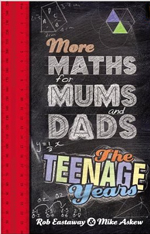'More maths for mums and dads'

More maths for mums and dads: The teenage years
By Rob Eastaway and Mike Askew
Have you ever watched a film's sequel and thought, "this is just the same characters doing more or less the same things in a slightly different setting"? Well, that is not the feeling you will get reading More maths for mums and dads even if you have already read Rob Eastaway's and Mike Askew's successful and informative first volume Maths for mums and dads. Both books have a two-pronged approach to supporting parents in helping their children learn mathematics. On the one hand the authors offer support in how to approach maths with one's offspring and on the other they explain the underlying mathematical concepts and skills.
You might expect that only the latter of these two would need to be adapted to cover the secondary curriculum as opposed to primary. But then, any parent of a teenager knows that their approach to everything, not least maths homework, is very different from what it was in primary school. The authors obviously know this (one might even think they had parented teenagers themselves at some point in their lives!), and the first chapters of the book reflect their understanding of the attitudes and issues peculiar to teenagers and their study of maths. In fact, there is so little repetition of the material in Maths for mums and dads that the authors specifically acknowledge instances where they have felt it would be useful to show something again, such as their table of rough metric-Imperial equivalents. Nevertheless, the first book is not prerequisite reading for the second, so that parents who have not needed or not been aware of any support until their children were in secondary school will find the book just as useful as Maths for mums and dads graduates.
For parents who just want to know how to get the answer to a particular question on their child's maths homework (probably at the insistence of their teenager who just wants the answer, let alone the "how to get it"), some patience will be required. The book starts with teenagers' attitudes and motivation, works through everyday skills and then tackles the heavy duty maths before finally considering exams and exam questions. This is undoubtedly the best approach, but often the exact reverse of the priorities of students, parents and even sadly teachers in some cases. The emphasis is on problem-solving, playing with maths puzzles and games and talking about maths, even answering the dreaded question "Why do I have to learn this?" Each topic is presented with some combination of interesting applications, historical background, personal experiences and humour. The authors have skillfully presented an overview of the big ideas in secondary mathematics which is accessible, logical and entertaining without being condescending so that parents from a wide range of mathematical backgrounds may benefit. Clearly not all topics can be covered in minute detail. For example, once quadratics have been explained and put into context, readers are directed to use the internet or textbooks to learn and practice specific techniques if desired. And circle theorems, a stumbling block for many GCSE students, get only the briefest mention within the answer to an exam question.
But this book is not intended to be a textbook, and although it is targeted at parents, it would be excellent summer reading for teachers as well. The book's focus on the big picture, the connections within mathematics and the references to historical developments and modern applications can be a welcome reminder (or even eye-opener) to teachers who risk getting bogged down in the detail of the syllabus. Teachers may also find useful alternative ways of explaining or approaching a topic as well as ways of contextualising and motivating study. There are also timely warnings of the dangers of mindless memorisation of algorithms and mnemonics which may only be partially or incorrectly remembered. As a teacher myself, I have some issues with some of the authors' alternative presentations, such as vertical tree diagrams or statements of probability in the form of ratios or "1 in n". Although these forms may be helpful for understanding, there should be caveats about expected presentation in exams. As a general rule, however, the authors' encouragement of non-standard and multiple alternative methods is most welcome. This acceptance of different routes to the same destination is perhaps the most important way to alleviate parents' fear of getting it wrong and teenagers' uneasiness about accepting parents' help.
Overall, this is an excellent book which would be beneficial to parents from a wide range of educational backgrounds as well as maths teachers and possibly even students themselves. The highlights include definitions of terminology, both throughout the text and in the glossary at the end; explanations of methods commonly taught in schools (and their rationale); and my personal favourite, the sections entitled If you only do three things (or four or five, as appropriate) at the end of each chapter. If you only do one thing to prepare yourself to support teenagers' learning of maths: read this book.
- Book details:
- More maths for mums and dads: The teenage years
- Rob Eastaway and Mike Askew
- hardback — 392 pages
- Square Peg (2013)
- ISBN: 978-0224095310
About the author
Kristin Coldwell is an experienced secondary maths teacher and the parent of two teenagers. She is also an Area Coordinator for the Further Mathematics Support Programme, which aims to promote the study of mathematics beyond GCSE.